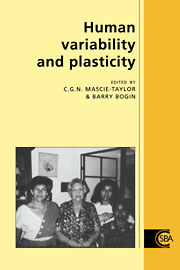Book contents
- Frontmatter
- Contents
- List of contributors
- Foreword
- 1 The pervasiveness of plasticity
- 2 Plasticity in early development
- 3 Plasticity in the growth of Mayan refugee children living in the United States
- 4 The place of plasticity in the study of the secular trend for male stature: an analysis of Danish biological population history
- 5 Plasticity, growth and energy balance
- 6 The study of migrants as a strategy for understanding human biological plasticity
- 7 Human migration: effects on people, effects on populations
- 8 The use of surnames in the study of human variation and plasticity
- 9 A biological anthropological approach to measuring societal stress of parasitic disease: a case study of schistosomiasis
- 10 Biological adaptability, plasticity and disease: patterns in modernizing societies
- 11 Human biological adaptability with special emphasis on plasticity: history, development and problems for future research
- Index
6 - The study of migrants as a strategy for understanding human biological plasticity
Published online by Cambridge University Press: 28 October 2009
- Frontmatter
- Contents
- List of contributors
- Foreword
- 1 The pervasiveness of plasticity
- 2 Plasticity in early development
- 3 Plasticity in the growth of Mayan refugee children living in the United States
- 4 The place of plasticity in the study of the secular trend for male stature: an analysis of Danish biological population history
- 5 Plasticity, growth and energy balance
- 6 The study of migrants as a strategy for understanding human biological plasticity
- 7 Human migration: effects on people, effects on populations
- 8 The use of surnames in the study of human variation and plasticity
- 9 A biological anthropological approach to measuring societal stress of parasitic disease: a case study of schistosomiasis
- 10 Biological adaptability, plasticity and disease: patterns in modernizing societies
- 11 Human biological adaptability with special emphasis on plasticity: history, development and problems for future research
- Index
Summary
The strategy of using migration studies to estimate the degree of human plasticity was developed by Boas (1911) and utilized by Shapiro, who directed the collection of data for this purpose by William Lessa (Shapiro, 1931), Frederick Hulse (Shapiro, 1939) and Frederick Thieme (Thieme, 1957). The early history of the subject is covered in the introductions to various research reports and in the review by Kaplan (1954). The subsequent development of the strategy has also been chronicled (Baker, 1976; Little & Baker, 1988). It remains for me only to give an informal account of some of my own research experiences.
As an undergraduate I had little exposure to research. In the summer of 1930 or 1931 I completed my requirements at the Experimental College of the University of Wisconsin by writing a social survey of the city of Yonkers, New York. All I remember about it is that the streets had been planned on a map and when actually constructed some of them ended abruptly at the foot of hills too steep to be climbed except by stairs. These impediments to road traffic coincided with the boundaries of neighborhoods.
A few years later – probably 1933 – a professor of international economics at the University of Michigan set me to study the rice trade of Indo-China. I had great trouble meeting the language requirement for graduation, but I enjoyed the same privilege as graduate students to work in the library stacks on French-language colonial reports.
After graduation from the University of Michigan in 1934 I taught myself human genetics and did the genetic analysis of an inborn error of metabolism that my mother, Margaret Lasker, and Morris Enklewitz had been studying from the biochemical and clinical points of view (Lasker, Enklewitz & Lasker, 1936).
- Type
- Chapter
- Information
- Human Variability and Plasticity , pp. 110 - 114Publisher: Cambridge University PressPrint publication year: 1995
- 5
- Cited by



